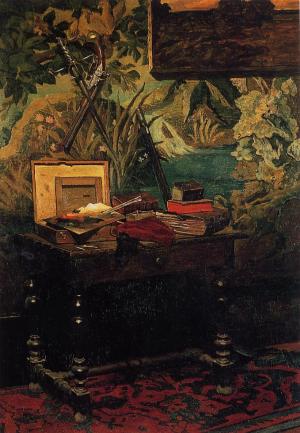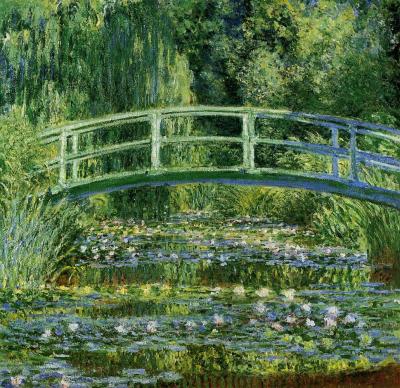The colors of Monet
En Francais :
Les Couleurs utilisées par Monet
![]()

Claude Monet, The Path among the Irises 1914-1917, detail
The colors of Monet
En Francais : |
|

Claude Monet, Studio Corner, 1861 |
Impressionist art is based on the use of color, which has to "draw" the
motive without resorting to line.
At the beginning of his career, Monet used dark colors, as he did in the 'Studio Corner' marked by black shades. His painting evokes Courbet and the Realist School. From 1860 on, Monet abandonned dark colors and worked from a palette limited to pure light colors. In 1905, answering a question about his colors, he wrote : "As for the colors I use, what's so interesting about that ? I don't think one could paint better or more brightly with another palette. The most important thing is to know how to use the colors. Their choice is a matter of habit. In short, I use white lead, cadmium yellow, vermilion, madder, cobalt blue, chrome green. Tha t's all." The color analysis enabled to identify the colors he used and the binder of the paintings : poppyseed oil and linseed oil. The former dries off slower and yellows less. |
The issue of blackPure black is rarely used by the impressionist painters. Monet obtained an appearence of black by combining several colors : blues, greens and reds. He eliminated almost completely black from his painting, even in the shadows. In the Red Boats, Argenteuil, shadows are purple. Avoiding black was so deeply anchored in Monet's manner that when he died, his friend Georges Clemenceau would not stand the black sheet covering the coffin. He exclaimed : "No ! No black for Monet !" and replaced it by a flowered material. |
Claude Monet, Red Boats in Argenteuil, 1875 |
Colors seen by an ill eyeIn 1908, aged 68, Monet was affected by cataracte at both eyes, he began to loose sight. The first signs of this cataracte can be found in the paintings he made in Venice in 1908. Cataracte is a progressive opacity of the crystalline lens that filters the colors. As cataracte develops, whites become yellow, greens become yellow-green and reds, oranges. Blues and purples are replaced by reds and yellows. Details fade out, shapes blurr and become hazy. When his vision altered, Monet went on with working. He could know what color he used by the labels and the unvarying order he set them on the palette. « My bad sight means that I see everything through a mist," he wrote. «Even so it is beautiful, and that's what I would like to show. » |
|
 Claude Monet, The Waterlily Pond, 1897 |
Monet was used to paint exactly what he saw. Gradually his paintings
are invaded by reds and yellows. Blues vanish. Details fade like in the Weeping
Willows of 1919 and the Waterlilies of 1920.
The effects of the cataracte on Monet can be observed from some paintings depicting the same motif, for instance « The Japanese Bridge "made in 1897 and "The Waterlily Pond" made in 1923. |
|
| I Nevertheless, his friend Georges Clemenceau convinced him to undergo surgery. In 1923, he could see again with his right eye, wearing special green glasses. But his vision was still altered, and he refused to undergo surgery for the left eye.
|
|
|
|
|
|
|
Claude Monet, The House seen from the Roses Garden, 1922-1924 |
||||
| Monet resume painting as soon as 1923. The house seen from
the roses garden shows the effects of the operation. In this series, Monet
painted either with his left eye suffering from cataracte - everything is
red, the sky is yellow - or with the operated eye - everything is blue.
“ I see blue, I don't see red anymore, nor yellow ; this bothers me terribly because I know that these colors exist, because I know that ther e is red, yellow, a special green, a particular purple on my palette ; I don't see them anymore as I used to see them in the past, and however I remember very well how it was like. ” In spite of this handicap, Claude Monet continued to paint until 1926, a few monthes before he died. |
||||
Monet's colors seen by an illustrator
| Bijou Le Tord is the author of the book 'A Blue Butterfly' which tells
the story of Claude Monet to young children.
"During the short trip I made to Paris and Giverny in preparing for this book, nothing I had seen or felt until then prepared me for what I was about to encounter at the Musée de L'Orangerie in Paris. This museum was built to house Monet's now world-famous Water Lilies paintings. As I stood there gaping at the pair of astonishing paintings, I had to humbly ask myself: How did he do it, using so few colors? When I was ready to paint my book, I hoped I would have the courage to use the same colors Monet used. And I did, following a list he had worked with in the latter part of his life. We now know that the list was incomplete. It shows only eight colors: silver, white, cobalt violet light, emerald green, ultramarine extra-fine, vermilion (rarely), cadmium yellow light, cadmium yellow dark, and lemon yellow. "And that's all!" as Monet himself exclaimed. It was not easy for me to use someone else's palette. But by some strange coincidence, my own colors were very close to those of Monet. " |
 |
Claude Monet Home Page | Monet paintings | Claude Monet Biography | Monet's house and garden in Giverny Monet colors | Monet Books | Monet exhibitions | Monet in Museums Further reading on Giverny Blog with sections on Monet's Water Garden, Monet's House, Monet's Life and Monet's painting. Paris 2012-2013 Exhibition: "Impressionism and Fashion at Musee d'Orsay |
© A. Cauderlier,
38 route de Giverny 27200 Vernon France,
Editor.
Last modified : Wednesday, 25-Oct-2006 13:42:25 EDT